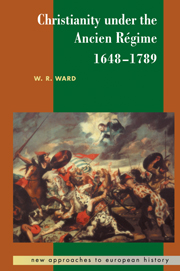Book contents
- Frontmatter
- Contents
- List of maps
- Preface
- Glossary
- 1 Peace and conflict: church and state in central and north-western Europe
- 2 Christianity in southern Europe
- 3 Catholicism in the Holy Roman Empire and the eastern Habsburg Lands
- 4 The religion of Protestants
- 5 Revival moves to the west
- 6 The Enlightenment and its precursors
- 7 The Churches in northern and eastern Europe
- 8 Religion after the Seven Years War
- Suggestions for further reading
- Index
- Title in the series
5 - Revival moves to the west
Published online by Cambridge University Press: 05 June 2012
- Frontmatter
- Contents
- List of maps
- Preface
- Glossary
- 1 Peace and conflict: church and state in central and north-western Europe
- 2 Christianity in southern Europe
- 3 Catholicism in the Holy Roman Empire and the eastern Habsburg Lands
- 4 The religion of Protestants
- 5 Revival moves to the west
- 6 The Enlightenment and its precursors
- 7 The Churches in northern and eastern Europe
- 8 Religion after the Seven Years War
- Suggestions for further reading
- Index
- Title in the series
Summary
Salzburg (1) Schaitberger
Two local dramas played out contemporaneously not in the Habsburg lands, but within their sphere of influence, further unsettled the Protestant world and signalled a shift westwards in the driving forces in it. The Salzburg emigration caused a shock everywhere, from Oxford common rooms normally devoted to port and politics to those attempting to complete Sweden's unfinished work in Christianising the Baltic provinces, and from the transatlantic colony of Georgia to Augsburg. The Moravian revival created a new kind of missionary force which carried the gospel to the ends of the earth, and with it a legend about the sorrows of central Europe and a vigorous feud with Halle. Revivalists like Wesley and Whitefield found that the Welds white to the harvest were hazardously mined.
Unforeseen as the great emigration from Salzburg in the winter of 1731–32 was, it was not unprecedented. Salzburg was both an archdiocese and a principality, though the boundaries of the two jurisdictions did not coincide, and they were not always harmoniously administered by the same person. Consistency indeed became a hazard when in the later seventeenth century the archbishops, hungry for money to Wnance their building schemes, set out to produce a loyal public by exterminating magicians, witches and Protestants. In 1683 this policy produced outbreaks of revival at the Dürrnberg and in the remote Defereggental.
- Type
- Chapter
- Information
- Christianity under the Ancien Régime, 1648–1789 , pp. 105 - 146Publisher: Cambridge University PressPrint publication year: 1999

